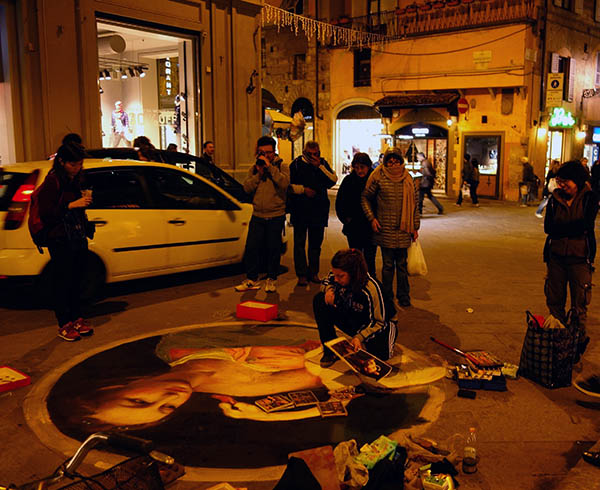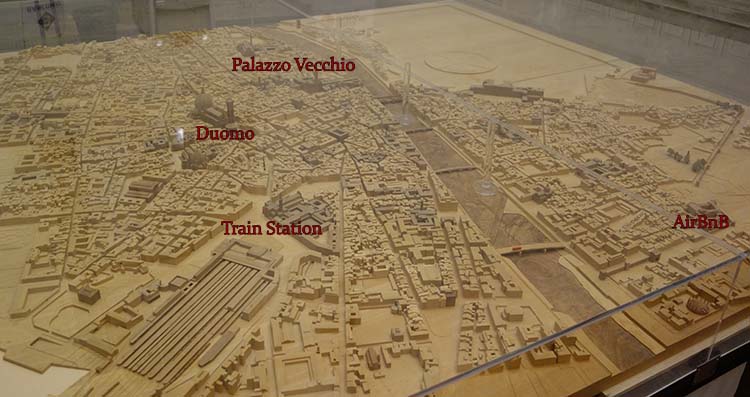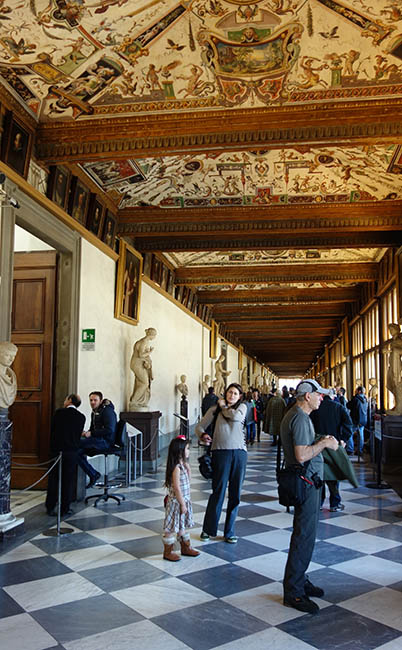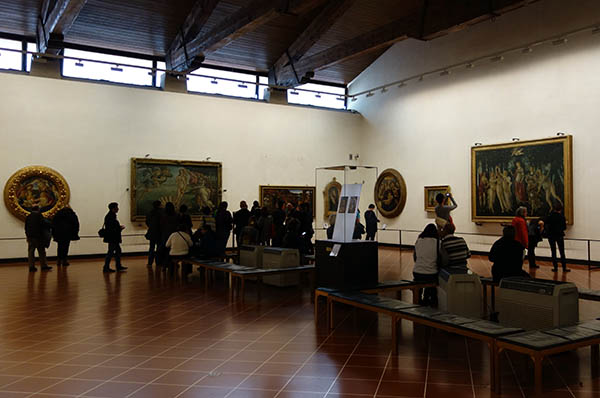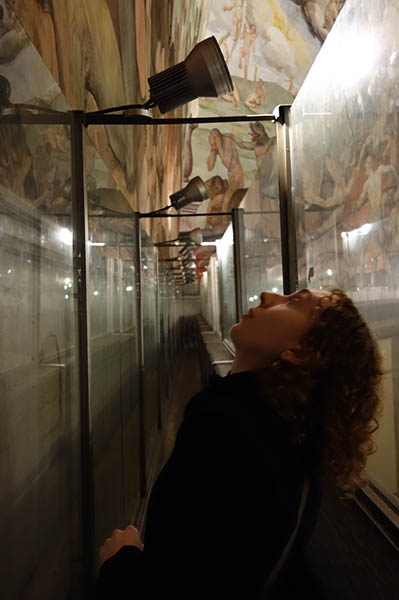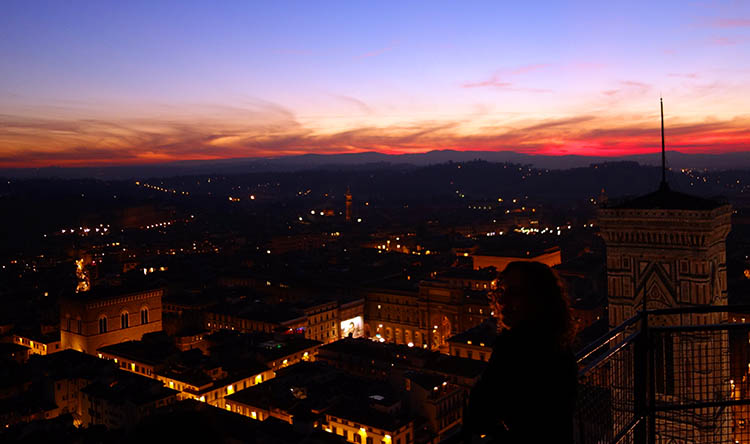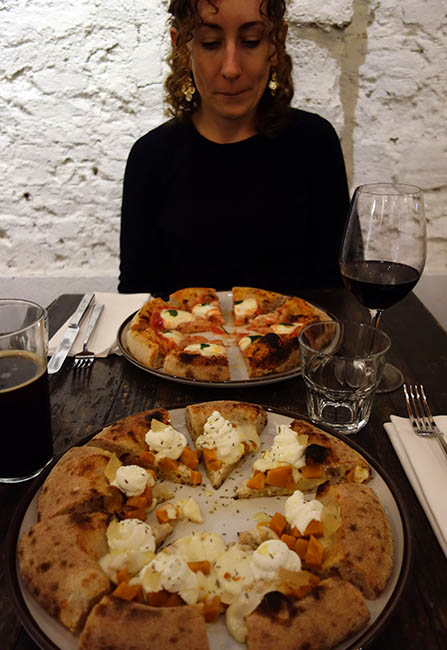We’d seen Florence at night, but there was so much to see in the city during the daytime. Among them, the Uffizi Gallery, the Bargello, the Palazzo Vecchio, Pitti Palace, Duomo, and dozens of smaller churches and museums. We had to balance this against our ever-present adversary: museum fatigue. In a given day, there’s only so many museums and cathedrals you can tolerate. And in a given week or month, you can only tolerate a bit more. So, we wanted to choose museums that represented the diversity of Italy, and which had little overlap with one another.
Thus, we chose to visit the Uffizi Gallery – one of the great collections of paintings in the world – and the Duomo, one of the brilliant architectural achievements of the Renaissance and a building that set the pattern for all domes that would follow – it’s still the largest masonry dome in the world.
We started our day walking along the Arno towards the old city, passing along the Ponte Vecchio in the meantime. The Uffizi Gallery is sandwiched between all the other major buildings, and overshadowed by the Palazzo Vecchio. We arrived early, worried that there might be a crowd. But, there wasn’t even a line to get in. In fact, you can purchase tickets in advance, for a small surcharge, to avoid lines. But, on this day, the line for online tickets was longer than that for buying in person. Crisis averted!
The Uffizi is really overwhelming, and it specializes in paintings, containing Botticellis, da Vincis, Michelangelos, Rembrandts, and much more besides. I won’t enumerate everything, but point out some highlights (from my perspective).
First, the Botticelli room, which contains mostly Botticellis – most notably the Birth of Venus and the Primavera. They occupy two adjacent walls, and are each 10 feet long. And yet, the room they’re in is quite overwhelming.
Actually, my favorite Botticelli was the Annunciation. Nearby is another painting with the same subject, this time by da Vinci (I liked the da Vinci, with its cool colors and detached emotion, better. Also for the remote fairytale city in the background).
It was also nice to get an up-close look at Michelangelo’s Doni Tondo, a painting in the same style as the Sistine Chapel. There were also some horrifying mannerist paintings by Rosso Fiorentino, a possibly insane Florentine artist who kept a baboon and lived in a tower (his assistants sent baskets of food up to him). There’s also one panel of the Battle of San Romano tryptich by Paulo Uccello, and a Rembrandt self-portrait.
The Uffizi has a relatively cheap cafe (at least, if you’re only ordering espressos), and a great view of the neighboring Palazzo Vecchio. We relaxed outside, enjoying the nice weather, and fed the docile finches crumbs of cookie from our hands. After continuing to wander through the museum, we walked 10 minutes through the old town to the Duomo. Our goal was to climb both the belltower and the Duomo itself before they closed for the evening. A nice sunset would be a plus…
The Duomo is the most famous feature of Florence (besides David, perhaps). Begun in 1296, it stood incomplete for 125 years, because it was so large that nobody knew how to construct the dome. That was a task left for the architect Brunelleschi, who won the appointment through a clever ruse. Around 1420, the local church was looking to complete the cathedral dome, and had a competition among the many (brilliant) Florentine architects. When they couldn’t reach a decision, Brunelleschi proposed the following: that whoever could stand an egg on end would be awarded the prize. All the other architects attempted this challenge, but none succeeded. Then Brunelleschi took the egg, smashed the end, and stood it upright, thus claiming the prize.
The dome itself has a clever design, two layers thick, and you can take stairs to the very top. There’s also an adjacent campanile (belltower), designed by the architect Giotto. This campanile is so narrow, and so high (277 feet) that I felt waves of acrophobia near the top. So, we didn’t spend much time enjoying the view, and went back downstairs to the Duomo itself.
What can I say? The view is spectacular, and we had a wonderful sunset, and you pass right under a vast (40,000 square foot) fresco by Georgio Vasari on the way up (this fresco took 11 years to complete). It was wonderful to see the sky turn from pale blue to pink to orange, to red, each color more unbelievable than the last.
Leaving the Duomo, we retraced our steps and crossed the river, out of the main tourist zone, to find a non-touristy restaurant. We hadn’t had a lot of pizza so far (Venice is not known as a good pizza town) and one suggested itself: “Pizza & Beer,” which served local craft beer, wine, and artisan pizza. I had a delicious chocolate stout, and we split two amazing pizzas: ricotta with pumpkin, and buffalo mozzarella. This was my second-favorite pizza place in Italy (my favorite was in Rome).
Then we went back to our apartment, because we’d have to get up very early the next day for an extensive tour of Tuscany featuring: wine, towers, horse races, more wine, and (maybe) the best gelato in the world.
